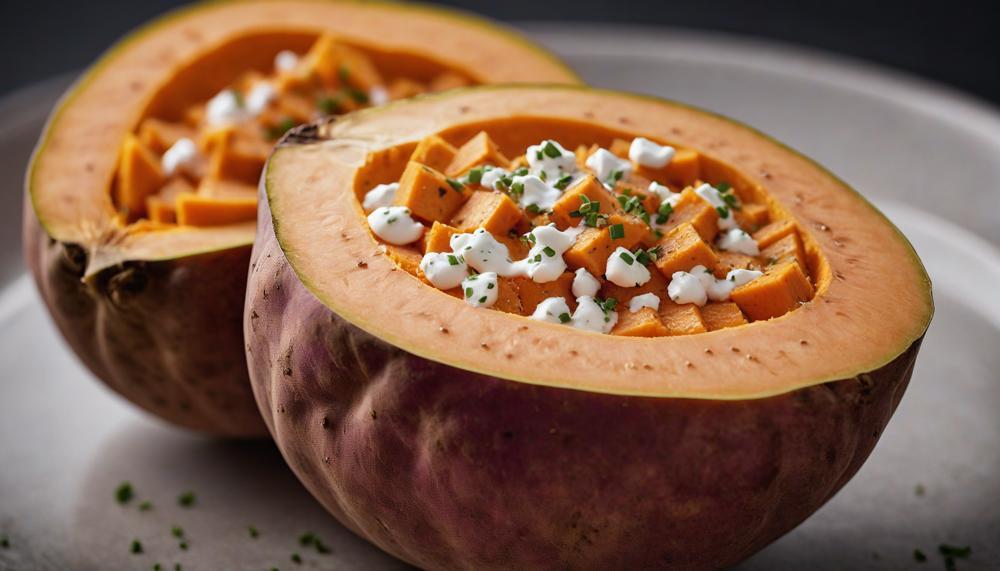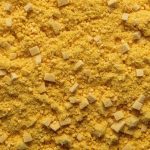Yes, white spots in sweet potatoes are safe to eat. These spots are usually just a natural part of the sweet potato’s life cycle and don’t indicate spoilage or contamination. Let’s dig into why these spots appear and what they mean for your meal planning.
Sweet potatoes are a beloved staple, rich in nutrients and flavor. But encountering white spots can be a bit concerning if you’re not sure what they signify. Here’s what you need to know:
- Natural Oxidation: When sweet potatoes are cut or bruised, they can develop white spots due to exposure to air. This oxidation is similar to how apples turn brown when cut.
- Varietal Differences: Some varieties of sweet potatoes are more prone to white spotting than others due to differences in their enzyme content and skin thickness.
- Storage Conditions: Exposure to light or temperature fluctuations can accelerate the formation of white spots. Keep your sweet potatoes in a cool, dark place to minimize this.
- Handling Practices: Rough handling during harvesting or transportation can lead to bruising, making sweet potatoes more susceptible to white spots.
- Nutritional Impact: These spots are purely cosmetic and do not affect the nutritional value or taste of the sweet potatoes.
- Prevention Tips: Store sweet potatoes properly and avoid washing them until you’re ready to use them to reduce the risk of oxidation.
- Consumer Awareness: Understanding that these spots are harmless can help reduce food waste and make meal preparation less stressful.
By being aware of these factors, you can confidently enjoy sweet potatoes without worrying about a few white spots. So, next time you see them, remember—they’re just a natural part of this versatile vegetable.
Contents
What Happens if You Eat a Bad Sweet Potato?
Eating a bad sweet potato can lead to food poisoning, causing a range of unpleasant symptoms. Here’s what you need to know:

Potential Symptoms
| Symptom | Description | Duration |
| Nausea | Feeling of sickness with an inclination to vomit. | Several hours to a couple of days. |
| Vomiting | Forcible voluntary or involuntary emptying of stomach contents. | Typically short-lived, but can recur. |
| Diarrhoea | Frequent, loose, or watery stools. | Can last a few days. |
| Abdominal Pain | Cramping or discomfort in the stomach area. | Several hours to a few days. |
| Fever | Elevated body temperature indicating an immune response. | Usually a few days. |
Causes of Spoilage
- Bacterial Contamination: Bacteria such as Salmonella, E. coli, or Listeria can contaminate sweet potatoes, especially if they are improperly stored.
- Mold Growth: Mold can develop on sweet potatoes, producing harmful mycotoxins. Consuming moldy sweet potatoes can lead to severe health issues.
- Natural Decay: Over time, sweet potatoes can naturally rot, leading to the breakdown of nutrients and the production of toxic compounds.
Signs of a Bad Sweet Potato
- Soft Spots: Indicate decay and potential mold growth.
- Discoloration: Black, brown, or dark spots suggest spoilage.
- Off Odour: A sour or rotten smell is a clear sign of spoilage.
- Wrinkled Skin: Indicates dehydration and age.
Prevention Tips
- Storage: Keep sweet potatoes in a cool, dry, and dark place.
- Handling: Avoid washing sweet potatoes before storage to prevent moisture buildup.
- Inspection: Regularly check stored sweet potatoes for signs of spoilage.
How Long Before a Sweet Potato Goes Bad?
Fresh sweet potatoes can last from 1 to 2 weeks at room temperature and up to a month if stored in a cool, dry, and dark place. Once cooked, they stay good for about 3 to 5 days when refrigerated and can be preserved for 10 to 12 months if frozen properly.
Storage and Shelf Life of Sweet Potatoes
| Condition | Storage Method | Duration |
|---|---|---|
| Fresh | Room Temperature | 1 to 2 Weeks |
| Fresh | Cool, Dry, Dark Place | Up to 1 Month |
| Cooked | Refrigerator | 3 to 5 Days |
| Cooked | Freezer | 10 to 12 Months |
Signs of Spoilage
To ensure you consume sweet potatoes before they go bad, look out for the following signs:
- Soft Spots: Fresh sweet potatoes should be firm. Any soft spots indicate spoilage.
- Discoloration: Look for any changes in color, especially black or brown spots.
- Odor: A foul or off smell is a clear sign that the sweet potato is no longer good to eat.
Tips for Extending Shelf Life
- Proper Storage: Keep sweet potatoes in a cool, dry, and dark place, like a pantry or cellar. Avoid storing them in the refrigerator while they are raw as this can alter their taste and texture.
- Avoid Moisture: Ensure the sweet potatoes are dry before storing to prevent mold growth.
- Freezing: For long-term storage, cook and then freeze sweet potatoes. This can extend their shelf life significantly.
By following these guidelines, you can enjoy sweet potatoes at their best and avoid the risks associated with consuming spoiled ones.
What Are Signs That Let You Know a Sweet Potato Has Gone Bad?
When determining if a sweet potato has gone bad, look for several clear signs. Here are the key indicators:
- Dark Spots and Holes: If you notice dark brown or black spots on the surface or any holes, the sweet potato is likely spoiled.
- Mold Growth: Mold, especially on the tips, is a definitive sign of spoilage, even if the rest of the sweet potato looks fine.
- Soft or Mushy Texture: Fresh sweet potatoes should be firm. If they feel soft, mushy, or spongy, discard them.
- Unpleasant Odor: A sour or rancid smell indicates the sweet potato has gone bad.
- Discoloration Inside: Cut open the sweet potato. If the interior is nearly black, mushy, or stringy, it’s spoiled.
- Weird Growths: Unusual sprouts or growths on the surface suggest the sweet potato is no longer good to eat.
- Wrinkling: Significant wrinkling or shriveling points to moisture loss and spoilage.
How to Store Sweet Potatoes?
Storing sweet potatoes properly is key to preventing the development of white spots, ensuring they remain fresh and delicious.
Curing Process:
- Sweet potatoes should be cured first in a warm, humid environment at approximately 85°F (29°C) with 90% humidity for 4 to 7 days. This process helps toughen the skin, heal minor cuts, and improve storage life.
Temperature Control:
- Store cured sweet potatoes in a cool, dark place with a consistent temperature between 55°F (13°C) and 60°F (15°C).
Temperatures below 55°F can cause hard, white spots in the centers, while temperatures above 60°F can lead to softening and sprouting.
Avoid Refrigeration:
- Do not store sweet potatoes in the refrigerator as it can negatively impact their flavor and texture, causing them to become hard inside.
The cold environment of a fridge is unsuitable for sweet potatoes and can promote the development of white spots.
Optimal Storage Locations:
- Ideal storage spots include pantry shelves, kitchen cabinets, or basements. Use baskets or breathable bags to allow for adequate air circulation and maintain freshness.
Handling and Packaging:
- Handle sweet potatoes gently to avoid bruising, which can lead to white spots.
Avoid washing them before storage as excess moisture can encourage oxidation and white spotting.
Can You Freeze Sweet Potatoes?
Yes, you can freeze sweet potatoes.
Sweet potatoes can be frozen in various forms such as cubed, wedged, fries, or mashed. Here’s a detailed guide on how to freeze sweet potatoes to maintain their quality and texture:
Preparation:
- Peel and Chop: Begin by peeling the sweet potatoes and chopping them into uniform pieces to ensure even freezing.
- Blanching: Blanch the pieces in boiling water for a few minutes, then quickly transfer them to an ice bath. This process helps preserve texture and colour.
- Drying: Pat the sweet potatoes dry to remove excess moisture.
Freezing:
- Initial Freeze: Arrange the blanched pieces on a baking sheet in a single layer and freeze them for a few hours. This step prevents the pieces from sticking together.
- Storage: Once frozen, transfer the sweet potatoes to an airtight container or freezer-safe bag to prevent freezer burn and maintain freshness.
Storage Duration:
- Properly stored, frozen sweet potatoes can last up to a year.
Thawing:
- When ready to use, thaw the sweet potatoes in the refrigerator to gradually bring them back to temperature, preserving their texture.
Conclusion
White spots on sweet potatoes often spark concern, but rest assured, these are harmless and a natural part of the vegetable’s lifecycle. Understanding why these spots occur can help reduce food waste and ensure a stress-free cooking experience.
- Natural Oxidation: Just like apples turn brown when cut, sweet potatoes can develop white spots from exposure to air. This oxidation process doesn’t affect their taste or nutritional value.
- Varietal Differences: Some sweet potato varieties are more prone to white spotting due to differences in enzyme content and skin thickness. Knowing this can help you choose varieties less likely to develop these spots if they bother you.
- Storage Conditions: Proper storage is crucial. Keep sweet potatoes in a cool, dark place to minimize white spot formation caused by light and temperature fluctuations. Avoid washing them before storage to prevent moisture buildup.
- Handling Practices: Rough handling during harvesting or transportation can bruise sweet potatoes, leading to white spots. Handle them gently to keep them in optimal condition.
By following these guidelines and understanding that white spots are just a cosmetic issue, you can enjoy the rich, nutritional benefits of sweet potatoes without worry.




